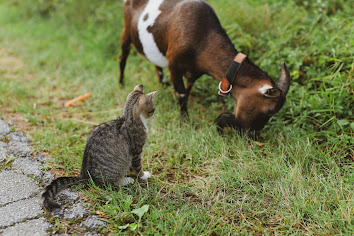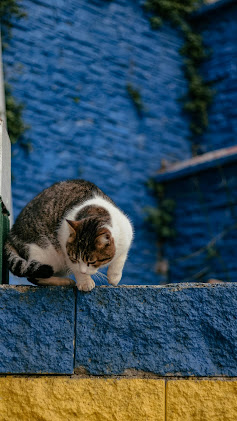Introduction:
Cats, those enigmatic and beloved companions, often seem to possess boundless energy and agility, coupled with moments of serene repose.
Ever wondered what drives these fascinating creatures? Join us on a deep dive into the world of cat metabolism, where we'll unravel the mysteries that underpin their unique physiology and dietary needs.
The Foundations of Cat Metabolism
Cats, scientifically known as Felis catus, are obligate carnivores, a term that encapsulates their evolutionary dependence on animal-based diets. This dietary specialization is deeply rooted in their ancestral history as hunters and reflects the unique metabolic adaptations that distinguish them from other mammals.
Evolutionary Origins:
The evolutionary journey of the domestic cat traces back thousands of years to its wild ancestors, such as the African wildcat (Felis lybica). These ancestral felines inhabited diverse habitats, from deserts to forests, and relied on hunting small prey for survival. Over time, natural selection favored traits that enhanced their ability to capture, digest, and derive energy from animal protein.
Adaptations for Carnivory:
The anatomical and physiological features of cats reflect their carnivorous lifestyle. From their sharp teeth and retractable claws to their short digestive tracts and specialized metabolic pathways, every aspect of their biology is finely tuned for hunting and consuming prey. Cats lack certain enzymes necessary for efficiently metabolizing plant-based nutrients, emphasizing the importance of a meat-centric diet for meeting their nutritional needs.
Unique Metabolic Pathways:
Central to cat metabolism is their reliance on protein and fat as primary energy sources. Unlike omnivores, which can derive energy from carbohydrates, cats have limited capacity to utilize sugars due to the absence of specific enzymes, such as amylase, in their saliva and pancreas. Instead, their bodies are adept at metabolizing amino acids from protein and fatty acids from fat, enabling them to maintain energy balance and metabolic homeostasis.
Nutritional Requirements of Cats
A balanced and species-appropriate diet is essential for supporting optimal health and well-being in cats. Understanding their specific nutritional requirements is paramount for selecting the right food and ensuring they receive all the essential nutrients necessary for growth, development, and maintenance.
Protein: The Foundation of Feline Nutrition
Protein is the cornerstone of the feline diet, serving as the primary source of essential amino acids necessary for building and repairing tissues, synthesizing enzymes and hormones, and supporting immune function. Cats have higher protein requirements compared to many other animals due to their unique metabolic physiology and evolutionary history as obligate carnivores.
Essential Nutrients:
In addition to protein, cats require specific nutrients that are crucial for their health and vitality. Taurine, for example, is an amino acid that plays a critical role in vision, cardiac function, and reproductive health. Cats are unable to synthesize taurine endogenously and must obtain it from their diet, highlighting its importance in feline nutrition.
Other essential nutrients for cats include:
- Arachidonic Acid: A fatty acid important for skin and coat health, as well as reproductive function.
- Vitamin A: Essential for vision, immune function, and skin health.
- Vitamin D: Necessary for calcium and phosphorus metabolism, bone health, and immune regulation.
- Omega-3 and Omega-6 Fatty Acids: Important for maintaining healthy skin, coat, and immune function.
Water and Hydration:
Proper hydration is crucial for maintaining metabolic health and supporting vital physiological functions in cats. Despite their low thirst drive, cats have a high requirement for water, especially when consuming dry food diets. Providing access to clean, fresh water at all times is essential for preventing dehydration and supporting kidney function.
Understanding Cat Energy Needs and Metabolic Rate
Energy metabolism plays a central role in regulating feline physiology, behavior, and overall health. Cats possess remarkable metabolic flexibility, allowing them to adapt to varying dietary conditions and energy demands.
Basal Metabolic Rate (BMR):
Basal metabolic rate refers to the minimum amount of energy required to sustain basic physiological functions while at rest. Cats have a relatively high BMR compared to many other mammals, reflecting their small size, high lean body mass, and energetic lifestyle. Factors such as age, sex, body composition, and environmental temperature can influence BMR in cats.
Factors Influencing Energy Requirements:
Several factors influence the energy needs of cats, including:
- Life Stage: Kittens, adult cats, and senior cats have different energy requirements based on their growth, maintenance, and activity levels.
- Activity Level: Active cats require more energy to support their daily activities, whereas sedentary cats may have lower energy needs.
- Neutering Status: Spayed or neutered cats may have altered metabolic rates and energy requirements compared to intact cats due to changes in hormone levels and activity levels.
- Environmental Temperature: Cats living in colder climates may require more energy to maintain body temperature, while those in warmer climates may have lower energy needs.
Feeding Behavior and Dietary Patterns:
Cats are natural grazers with a preference for frequent, small meals throughout the day. This feeding behavior reflects their hunting instincts and the metabolic advantages of consuming multiple small meals, such as improved nutrient absorption and energy utilization. Free-choice feeding, where food is available ad libitum, can help mimic natural feeding patterns and prevent overeating in cats.
Health Implications of Cat Metabolism
Optimal metabolic health is essential for ensuring longevity, vitality, and disease resistance in cats. Imbalances in energy metabolism, nutrient intake, or metabolic regulation can predispose cats to various health issues, ranging from obesity and diabetes to nutritional deficiencies and organ dysfunction.
Obesity:
Obesity is a common nutritional disorder in cats, characterized by excess body fat accumulation and an increased risk of metabolic and cardiovascular complications. Contributing factors to feline obesity include overfeeding, lack of physical activity, genetic predisposition, and metabolic imbalances. Obesity can lead to numerous health problems, including diabetes mellitus, osteoarthritis, respiratory issues, and decreased lifespan.
Diabetes Mellitus:
Diabetes mellitus is a metabolic disorder characterized by impaired insulin production or insulin resistance, leading to elevated blood glucose levels. Obesity, aging, genetics, and certain medical conditions can increase the risk of diabetes in cats. Proper management of feline diabetes involves dietary modifications, insulin therapy, weight management, and regular monitoring of blood glucose levels.
Renal Disease:
Chronic kidney disease (CKD) is a common age-related condition in cats, characterized by progressive loss of kidney function over time. Cats with CKD may experience alterations in metabolic rate, electrolyte imbalances, and changes in fluid balance. Nutritional management plays a crucial role in supporting kidney function, managing clinical signs, and slowing disease progression in cats with CKD.
Hyperthyroidism:
Hyperthyroidism is a hormonal disorder caused by overproduction of thyroid hormones, leading to increased metabolic rate and hyperactivity. Common clinical signs of hyperthyroidism in cats include weight loss, increased appetite, hyperactivity, and vomiting. Treatment options for hyperthyroidism may include medication, radioactive iodine therapy, or surgical removal of the thyroid gland.
Practical Tips for Nurturing Cat Metabolism
Maintaining
metabolic health in cats requires a holistic approach that encompasses nutrition, lifestyle management, preventive care, and veterinary guidance. Here are some practical tips for nurturing your cat's metabolism and promoting overall well-being:
Choose High-Quality Nutrition:
Select cat food formulas that are specifically formulated to meet the nutritional needs of cats at different life stages. Look for products that prioritize high-quality animal proteins, essential nutrients, and natural ingredients, while avoiding fillers, artificial additives, and excessive carbohydrates. Consult with your veterinarian for recommendations tailored to your cat's individual needs and preferences.
Monitor Body Condition:
Regularly assess your cat's body condition score (BCS) to ensure they maintain a healthy weight and body composition. Use visual and tactile cues to evaluate body fat distribution, muscle tone, and overall body condition. Cats with an ideal BCS should have a visible waist when viewed from above and be able to feel their ribs with gentle palpation.
Provide Enrichment and Exercise:
Promote physical activity and mental stimulation through interactive play, environmental enrichment, and puzzle feeders. Encourage your cat to engage in natural behaviors such as hunting, climbing, scratching, and exploring their environment. Regular exercise not only helps maintain a healthy weight but also stimulates metabolic activity, supports musculoskeletal health, and prevents behavioral problems.
Maintain Hydration:
Ensure your cat has access to clean, fresh water at all times to support proper hydration and kidney function. Consider incorporating wet food into their diet to increase moisture intake and prevent urinary tract issues. Monitor your cat's water intake and urine output as indicators of hydration status and urinary health.
Schedule Regular Veterinary Check-ups:
Schedule annual wellness exams with your veterinarian to monitor your cat's overall health, detect any underlying medical conditions, and assess metabolic parameters such as weight, body condition, and bloodwork. Follow your veterinarian's recommendations for preventive care, vaccinations, parasite control, and dental health to promote longevity and quality of life in your cat
Conclusion:
In conclusion, cat metabolism is a multifaceted and dynamic aspect of feline physiology that profoundly influences their health, behavior, and nutritional needs. By gaining a deeper understanding of cat metabolism and implementing proactive strategies for supporting metabolic health, we can help our feline companions thrive and enjoy fulfilling lives. Whether through proper nutrition, environmental enrichment, or preventive care, let's continue to nurture our bond with cats and celebrate the wonders of their metabolic prowess.







